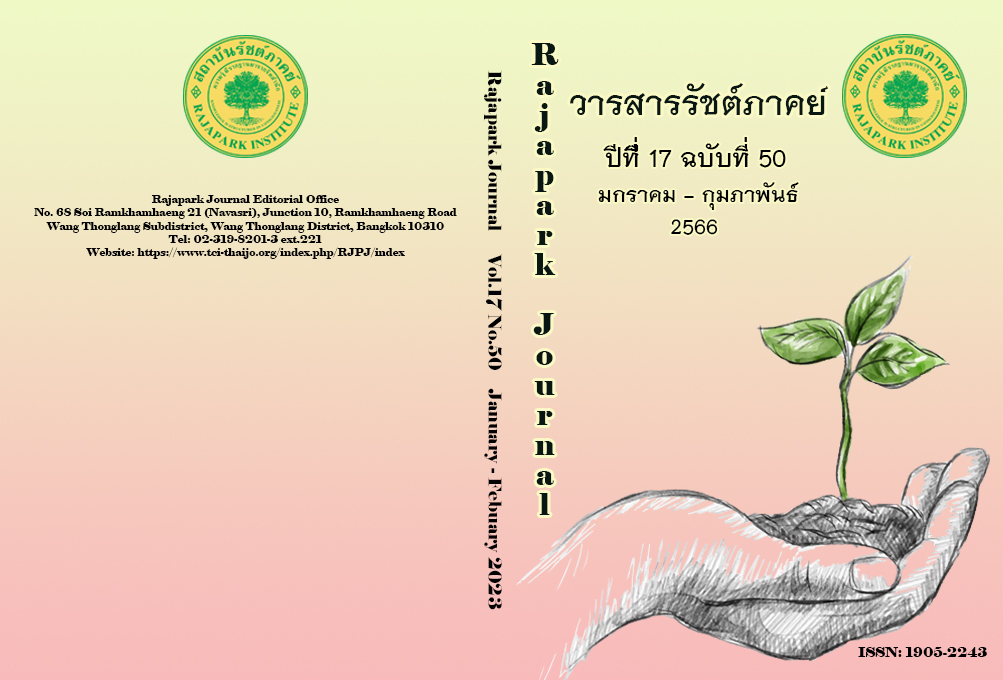ปัจจัยเชิงสาเหตุที่มีอิทธิพลต่อประสิทธิผลของทีมในโรงเรียนมัธยมศึกษา สังกัดสำนักงานเขตพื้นที่การศึกษามัธยมศึกษาชลบุรี ระยอง
Main Article Content
บทคัดย่อ
การวิจัยนี้มีวัตถุประสงค์เพื่อศึกษา 1) ระดับปัจจัยด้านบริบทองค์กร ด้านคุณลักษณะของทีม ด้านกระบวน การของทีม และประสิทธิผลของทีมในโรงเรียน 2) ความสัมพันธ์ของปัจจัยด้านบริบทองค์กร ด้านคุณลักษณะของทีม ด้านกระบวนการของทีมกับประสิทธิผลของทีมในโรงเรียน 3) อิทธิพลทางตรงและทางอ้อมที่มีต่อประสิทธิผลของทีมในโรงเรียน โดยเป็นการวิจัยเชิงปริมาณ กลุ่มตัวอย่าง คือ ครู สังกัดสำนักงานเขตพื้นที่การศึกษามัธยมศึกษาชลบุรี ระยอง จำนวน 357 คน จากการสุ่มแบบแบ่งชั้น เครื่องมือที่ใช้ คือ แบบสอบถาม สถิติที่ใช้ คือ ค่าเฉลี่ย ส่วนเบี่ยงเบนมาตรฐาน ค่าสัมประสิทธิ์สหสัมพันธ์เพียร์สัน และการวิเคราะห์เส้นทาง ผลการวิจัยพบว่า 1) ระดับปัจจัยด้านบริบทองค์กร ด้านคุณลักษณะของทีม ด้านกระบวนการของทีม ประสิทธิผลของทีม โดยภาพรวมอยู่ในระดับมาก 2) ปัจจัยด้านบริบทองค์กร ด้านคุณลักษณะของทีม ด้านกระบวนการของทีมมีความสัมพันธ์กับตัวแปรประสิทธิผลของทีม 3) เส้นทางอิทธิพลทางตรงและทางอ้อม (1) ปัจจัยด้านคุณลักษณะของทีม ด้านกระบวนการของทีม มีอิทธิพลทางตรงต่อประสิทธิผลของทีม (2) ปัจจัยด้านบริบทองค์กรส่งอิทธิพลทางอ้อมต่อประสิทธิผลของทีม ผ่านปัจจัยด้านคุณลักษณะของทีม และปัจจัยด้านกระบวนการของทีม
Article Details

This work is licensed under a Creative Commons Attribution-NonCommercial-NoDerivatives 4.0 International License.
ทัศนะและความคิดเห็นที่ปรากฏในวารสาร ถือเป็นความรับผิดชอบของผู้เขียนบทความนั้น และไม่ถือเป็นทัศนะและความรับผิดชอบของกองบรรณาธิการ
References
Akakulanan, S. (2008). EQ: Personnel and Team. Journal of Social Sciences and Humanities, 34 (2), 40-54.
Borrill, C., & West, M. (2002). Team Working and Effectiveness in Health Care: Findings from the Healthcare Team Effectiveness Project. Aston Centre for Health Service Organization Research.
Bussadee, S. (2016). The Causal Relation Model of Factors Affecting Teamwork Effectiveness in Schools under The Northeast Primary Education Service Area Office[Doctoral Dissertation, North Bangkok University].
Campion, M.A., Medsker, G.J., & Higgs, A.C. (1993). Relations Between Work Group Characteristics and Effectiveness: Implications for Designing Effective Work Groups. Personnel Psychology, 46(4), 823–847. https://doi.org/10.1111/j.1744-6570.1993.tb01571.x
Campion, M.A., Papper, E.M., & Medsker, G.J. (1996). Relations Between Work Team Characteristics and Effectiveness: A Replication and Extension. Personnel Psychology, 49(2), 429-452. https://doi.org/10.1111/j.1744-6570.1996.tb01806.x
Chantasorn, T., Manoosilp, P., & Rimcholakarn, Y. (2015). Factors Affecting Team Effectiveness in Educational Institution under Loei Provincial office of The Non-Formal and Informal Education. Humanities and Social Sciences Journal of Pibulsongkram Rajabhat
University, 9(1), 109–130. https://so01.tci-thaijo.org/index.php/GraduatePSRU/article/view/55658
Charuaendet, W., Surakitbowon, S., Koomkhainam, T., & Chalakbang, W. (2016). A Linear Structural Relationship Model of Quality Teams Affecting Primary School Effectiveness in the Northeast Under the Office of the Basic Education Commission. Nakhon Phanom University Journal, 6(1), 24–33.
Cohen, S. G. (1994). Designing Effective Self-Managing Work Teams. In M.M. Beyerlein & D.A. Johnson (Eds.), Advances in Interdisciplinary Studies of Work Teams: Theories of Self-Managing Work Teams, (pp. 67–102). Elsevier Science/JAI Press.
Conley, S., Fauske, J., & Pounder, D. G. (2004). Teacher Work Group Effectiveness. Educational Administration Quarterly, 40(5), 663–703. https://doi.org/10.1177/0013161X04268841
Cronbach, L. J. (1990). Essential of Psychological Testing (5th ed.). Harper Collins.
Durham, C.C., Knight, D., & Locke, E.A. (1997). Effects of Leader Role, Team-Set Goal Difficulty, Efficacy and Tactics on Team Effectiveness. Organizational Behavior and Human Decision Processes, 72, 203-231. http://dx.doi.org/10.1006/obhd.1997.2739
Gardner, D.G., & Pierce, J.L. (2001). Organization-based Self-esteem, Generalized Self-efficacy, and Affective Reactions to the Workplace: An Empirical Re-examination. Journal of Management Systems, 13(4), 31-48.
Gladstein. D.A. (1987). Demography and Design: Predictors of New Product Team Performance. Sloan School of Management, Massachusetts Institute of Technology (MIT). http://hdl.handle.net/1721.1/2332
Goodman, P.S., Ravlin, E., & Schminke, M. (1987). Understanding Groups in Organizations. Research in Organizational Behavior, 9, 121–173.
Hackman, J.R., & Oldman, G. (1980). Work Redesign. Addison-Wesley.
Joreskog, K. G., & Sorbom, D. (1984). Lisrel VI. Analysis of Linear Structural Relationships by Maximum Likelihood, Instrumental Variables, and Least Squares Methods. Scientific Software.
Khotnarin, W., & Treputtharat, S. (2011). Factors Affecting the Effectiveness of Teams in Secondary Schools under the Office of Secondary Educational Service Area 25. Journal of Education Graduate Studies Research Khon Kaen University, 5(2), 100-106. https://so02.tci- thaijo.org/index.php/EDGKKUJ/article/view/50558/41829
Kiniman, K., Pakasat, N., & Penpokai, N. (2019). Causal Relationship Model of Factors Related to Effectiveness of Working Team in Hospitals. Human Resource and Organization Development Journal, 11(1), 1-25. https://so01.tci-thaijo.org/index.php/HRODJ/article/ view/159618
Kreitner, R., & Kinicki, A. (2004). Organizational Behavior (6th ed.). McGraw-Hill.
Krejcie, R.V., & Morgan, D.W. (1970). Determining Sample Size for Research Activities. Educational and Psychological Measurement, 30(3), 607-610.
Kwak, E.J.L. (2004). Team Effectiveness and Characteristics: Apparel Product Development Teams[Doctoral Dissertation, The Florida State University]. https://diginole.lib.fsu.edu/islandora/object/fsu:181227/datastream/PDF/view
Meesomsap, A. (2010). A Study of Relationship Between Team Work and Academic Administration of Schools under The Office of PhranaKhon Si Ayutthaya Educational Service Area 1[Master’s Thesis, Phranakhon Si Ayutthaya Rajabhat University].
Manoosilp, P. (2008). A Structural Equation Modeling of Factor Affecting Team Effectiveness in The Schools under The Office of The Basic Education Commission[Doctoral Dissertation, Khon Kaen University].
Manoosilp, P. (2015). Factors Affecting Team Effectiveness. Humanities and Social Sciences Journal of Pibulsongkram Rajabhat University, 9(2), 1–28. https://so01.tci-thaijo.org/index.php/GraduatePSRU/article/view/55699
Phao-ard, L. (2016). Team Working of Teachers in Mueang Trat Expanding Opportunity Schools under Trat Primary Educational Service Area Office[Master’s Thesis, Burapha University].
Schermerhorn, Jr. J.R. (2005). Management (8th ed.). John Wiley & Sons.
Sundstrom, E. (1999). Work Groups: From the Hawthorne Studies to Work Teams of the 1990s and Beyond. Group Dynamics, Theory, Research, and Practice, 4(1), 44-67.
Werner, J.M., & Lester, S. W. (2002). Applying a Team Effectiveness Framework to the Performance of Student Case Teams. Human Resource Development Quarterly, 12(4), 385-402. https://doi.org/10.1002/hrdq.1004
Woodcock, M., & Francis, D. (1994). Teambuilding strategy (2nd ed.). Gower Publishing.
Yeatts, D.E., & Hyten, C. (1998). High-Performing Self-Managing Work Teams A Comparison of Theory to Practice. Sage Publication. https://doi.org/10.4135/9781483328218

